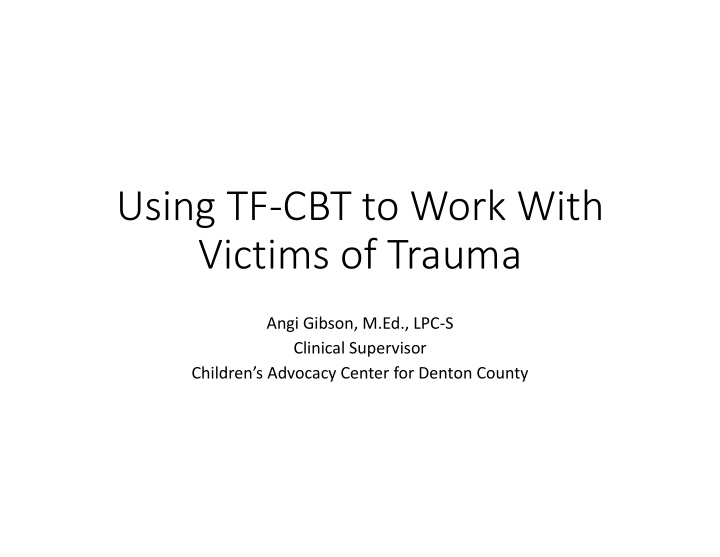



Using TF ‐ CBT to Work With Victims of Trauma Angi Gibson, M.Ed., LPC ‐ S Clinical Supervisor Children’s Advocacy Center for Denton County
Source accessed 2/24/2019: https://www.cdc.gov/violenceprevention/childabuseandneglect/acestudy/ace ‐ graphics.html
T RA UM A A ND T HE BRA IN CORTISOL OXYTOCIN
(Siegel & Hartzell, 2004)
What is TF ‐ CBT? TF-CBT is an evidence-based treatment for children and adolescents impacted by trauma and their parents or caregivers. It is a components-based treatment model that incorporates trauma-sensitive interventions with cognitive behavioral, family, and humanistic principles and techniques. TF-CBT has proved successful with children and adolescents (ages 3 to 18) who have significant emotional problems (e.g., symptoms of posttraumatic stress disorder, fear, anxiety, or depression) related to traumatic life events. It can be used with children and adolescents who have experienced a single trauma or multiple traumas in their lives. (https://www.nctsn.org/interventions/trauma-focused-cognitive-behavioral-therapy- accessed 2/27/2019)
TF CBT Model • P – Parenting and Psychoeducation • R – Relaxation • A – Affect Modulation • C – Cognitive Coping • T – Trauma Narrative • I – In ‐ vivo Gradual Exposure • C – Conjoint Parent Child Sessions • E – Enhanced Safety and Future Development (Cohen, Mannarino, & Deblinger, 2006)
Psychoeducation ABUSE TRAUMA AND THE BRAIN BODY PARTS/SEX ED/STD/PREGNANCY SAFETY TRIGGERS GROOMING HEALTHY RELATIONSHIPS BOUNDARIES
Parenting Praise Positive Attention Active Listening Appropriate Rewards Clear House Rules Clear consequences Active Ignoring (Cohen, Mannarino, Deblinger, 2012)
Relaxation Quick Grounding Techniques Relaxation Breathing Thought Stopping Progressive Muscle Relaxation Lifestyle Hygiene Exercise Self ‐ Care Doing Things you Like to do
Affect Regulation ‐ IDENTIFY MY FEELINGS ABOUT FEELINGS ‐ IDENTIFY MY FEELINGS ‐ WHAT ARE FEELINGS ‐ COPING WITH FEELINGS ‐ BEGIN TOLERATING MY FEELINGS ABOUT THE ABUSE
Cognitive Coping Feelings Thoughts Behavior
Trauma Narrative Processing thoughts and feelings about the abuse in detail ‐ Tell the story of the trauma in a safe environment ‐ Integrate the traumatic experience so that it is cognitively manageable ‐ Allow corrective emotional re ‐ working of the trauma ‐ Reduce emotional charge related to the trauma ‐ Process grief and loss associated with the trauma
In Vivo Gradual Exposure Talking about the trauma begins at the start of treatment but is very gradual and slow taking into account the needs of the client. Gradual exposure can reduce anxiety and decrease dysfunctional avoidant behaviors.
Conjoint Parent Sessions
Enhanced Safety & Future Planning Review previous safety education Identify ways to keep safe in the future Road map of life
Pros and Cons Does not address Symptom family system Reduction Not as flexible as Gives therapist other models an evidence ‐ based format
Assessment‐Based Treatment for Traumatized Children: A Trauma Assessment Pathway TA TAP SOURCE: Chadwick SOURCE: Chadwick Center for Children And Families SOURCE: Chadwick for Children Center for Children And Families And Families
TRA TRAUMA IN INFORMED CARE CARE Developmentally Appropriate Psychoeducation Family Systems & Skill Building Addressing Trauma integration Cognitive Distortions Affect Regulation Suzy Gange, LPC ‐ S, 2016
References/Sources ACES Study: https://www.cdc.gov/violenceprevention/childabuseandneglect/acestudy/ace ‐ graphics.html (Source accessed 2/24/2019) For more information on TF ‐ CBT: https://www.nctsn.org/interventions/trauma ‐ focused ‐ cognitive ‐ behavioral ‐ therapy Trauma Focused CBT for Children and Adolescents, Treatment Applications (2012) Edited by J. Cohen, A. Mannarino, and E. Deblinger. The Guildford Press, New York. For more information about TAP: https://www.nctsn.org/interventions/assessment ‐ based ‐ treatment ‐ traumatized ‐ children ‐ trauma ‐ assessment ‐ pathway
Recommend
More recommend